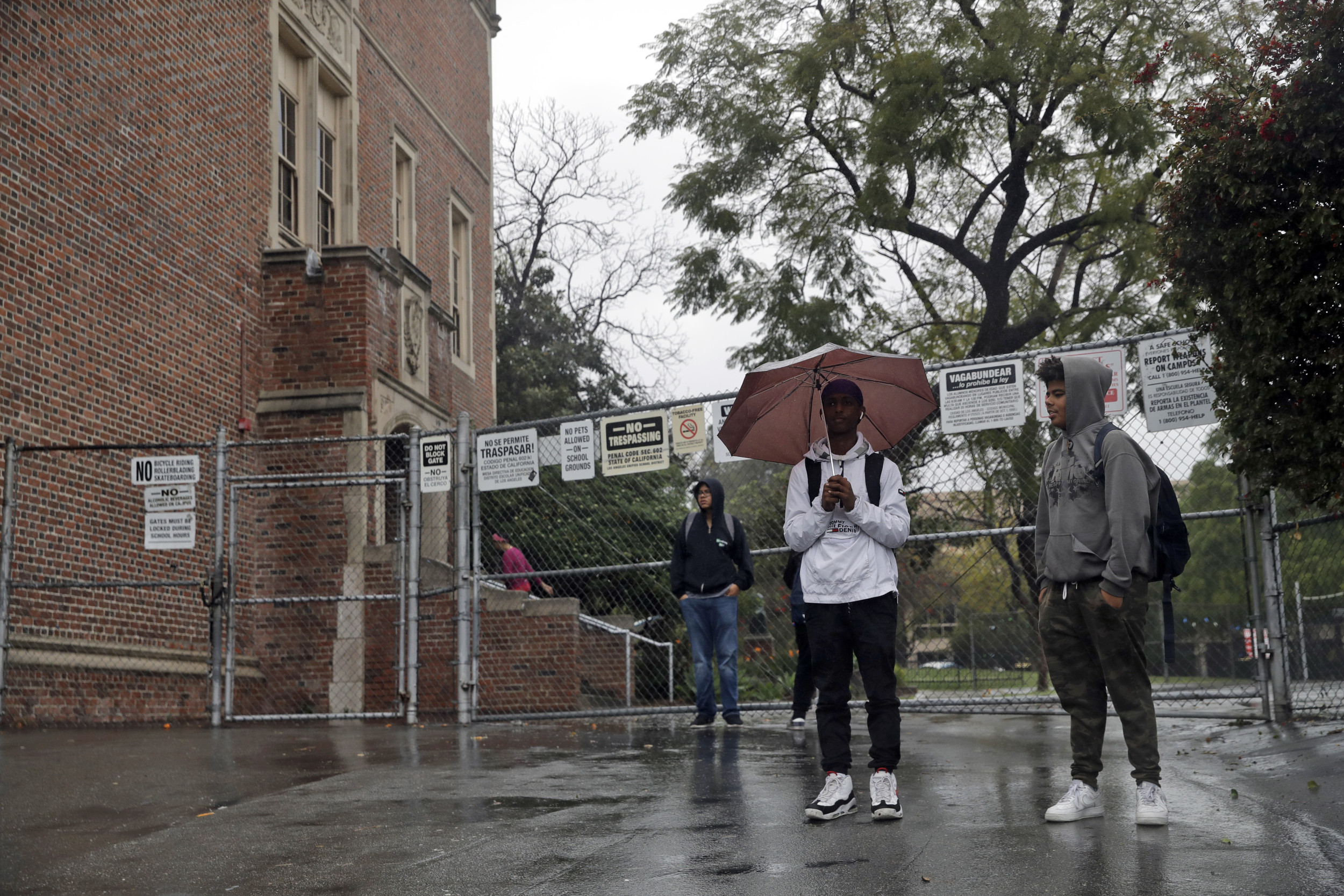California
What Blue States Can Do If Trump and Republicans Withhold Disaster Aid

As fires continue to devastate Los Angeles County, a president will soon be inaugurated who has promised to withhold federal help from states like California if Democratic lawmakers there don’t sing to his tune. Donald Trump threatened to withhold federal disaster relief from the state just months ago, and he recently repeated that threat.
There’s plenty of reason to believe Trump means it, too, considering he reportedly delayed or withheld disaster aid to blue states and Puerto Rico during his first term as president.
Republican lawmakers like Rep. Warren Davidson (R-Ohio) have also raised the idea in light of the California wildfires, while House Speaker Mike Johnson (R-La.) said on Monday that he believes federal aid should be conditional. “It appears to us that state and local leaders were derelict in their duty in many respects. So that’s something that has to be factored in,” Johnson said, echoing the larger right-wing response to the fires, which has been to blame Democrats.
Sen. Tommy Tuberville (R-Ala.) chimed in later on Monday. “They don’t deserve anything, to be honest with you,” he said of the prospect of outside aid coming into California, citing “inner-city woke policies.”
The wildfires in California have burned roughly 40,000 acres of land — or about 62 square miles — which is nearly three times the size of Manhattan. The Santa Ana winds are expected to pick up and increase the risk of fires spreading further. If Trump were to deny a state like California federal aid during such a disaster, the consequences could be enormous.
“It would be unprecedented. The longstanding protocol among presidential administrations has been to leave any kind of electoral politics behind when it comes to any disaster declarations,” says Jesse Keenan, an associate professor and director of the Center on Climate Change and Urbanism at Tulane University. “The impacts would be devastating.”
In response to the Los Angeles fires, President Joe Biden on Jan. 8 approved a Major Disaster declaration that directed government funds to support the region’s recovery and help pay for the cost of fighting the fires. The administration also deployed large air tankers and federal firefighting helicopters operated by the U.S. Forest Service to help fight the fires.
“There are different faces to federal involvement in disasters,” says Daniel Farber, a law professor at the University of California, Berkeley. “There’s somebody that’s available beforehand to try to reduce risks of various kinds, there’s the immediate disaster response where you see the guys with the FEMA jackets on the ground, and then there’s this longer term rebuilding process, which can take years, and there’s federal aid for reconstruction.”
Beyond helping deal with the disaster initially, the most significant role of the federal government is to help the affected region recover. Keenan says that means helping to pay for debris removal and the repair of critical infrastructure. When necessary, it may also pay to upgrade infrastructure to help prepare for future threats.
“These are very large upfront costs,” Keenan says. “The federal government, when they deploy this money for debris removal and for individual assistance and all of that money that floods in after a disaster, it really does a lot to stabilize the local economy. Without it — if you remove those federal dollars — you see a real delay in the return of what we call normal, stabilized economic outputs.”
Without that money, Keenan says, it would take these communities a lot longer to recover from a disaster. That might mean another disaster could strike while the recovery from the last one is still ongoing. Federal resources allow a community to recover as quickly as possible and hopefully prepare for the next disaster before it happens.
“You could see damage to the community for years or decades if the federal government sort of boycotted the disaster relief,” Farber adds.
Knowing that the Trump administration may be considering withholding federal aid from blue states in the future, governors and other leaders in these states may want to consider how to prepare for such an occasion. There are some things these lawmakers could do if help is denied, but they will never fully replace the impact of the federal government intervening.
“There is a compact between the states to help each other called EMAC,” Farber says. “That’s been used quite a number of times. That’s a possibility, to make preparations and think about what other states you might want to call on and what you would ask them to do.”
Keenan says he might recommend that blue states start to get financially prepared for disasters in ways they haven’t necessarily needed to in the past. That could involve putting money aside for future disasters and creating lines of credit for municipalities that could be affected.
“I would try to create budget line items where I start putting money away — where I have contingency funds, as well as opening pools for lines of credit for local governments,” Keenan says. “It’s not just the cash. It’s also creating credit facilities, which may mean lending pools, that local governments could borrow against for short-term credit needs.”
Farber says that if the federal government decides to deny aid for purely political reasons, states may want to be prepared to sue the government and see how that plays out in the courts.
“If the president just said ‘no’ without an explanation, then it would be really hard to sue,” Farber says. “If the president said it was because you voted against him, then there’s a chance of it succeeding in court.”
The federal government is typically expected to step in and help a community when it faces a natural disaster, the idea being that we’re all in this together, and we should help each other in times of need, regardless of political affiliation. The Biden administration sent federal help to red states that had been ravaged by hurricanes last year, even while Trump tried to claim he was withholding it for political reasons.
“In moments like this, it’s time to put politics aside,” Biden said during a visit to Georgia following Hurricane Helene. “It’s not one state versus another — it’s the United States.”
It’s clear Trump doesn’t see it that way. The president-elect is transactional, and he is spiteful, so states may not be able to consistently rely on federal help going forward. However, Trump may find himself in a political bind if he starts threatening to withhold aid due to how the electoral map looks in this country.
“Disproportionately in this country, disaster declarations are made in red counties,” Keenan says. “You can pick on Nevada or California or Virginia or wherever, but it’s not going to be so easy politically,” he adds, noting that Trump could wind up hurting his own supporters by using disaster relief to carry out his political vendettas.
Perhaps, for this reason, he may be hesitant to do so. That being said, Trump has not always been known to let logic get in the way of his actions.

California
Yosemite to reopen Tioga Road on Memorial Day

Yosemite National Park’s eastern entrance will reopen just in time for Memorial Day, officials announced this week.
Tioga Road — a popular scenic section of Highway 120 — has been closed due to ice and snow since November. It will reopen to all traffic at 8 a.m. Monday, according to the National Park Service.
The road is typically closed each year between November and late May or early June due to wintry conditions, while all other park entrances remain open year-round. The 45-mile road closure extends from the Tuolumne Grove east of Crane Flat to the Tioga Pass Entrance Station.
Preparing the road for reopening is a significant undertaking that includes plowing through multiple avalanche zones, clearing downed trees and rockfalls, and preparing campgrounds and critical facilities for visitors, according to the park service.
This year’s May 26 reopening is about two weeks earlier than last year — and about a month earlier than the year prior, park data show.
Additionally, the park service will not provide early access to Tioga Road for cyclists this year, as they do some years. Some cyclists were upset by the announcement.
“It’s outrageous that they’re not giving two days to cyclists on the road system without cars this year,” one Reddit user wrote in the Yosemite forum, adding that they planned to write a letter to the park service and their local representative about the decision.
“Cyclist-only days should be a tradition that is celebrated and encouraged, not an afterthought in favor of motorists,” another person wrote.
But officials are bracing for a busy season. Visitors who plan to enter Yosemite between 6 a.m. and 2 p.m. this holiday weekend will need a reservation and should be prepared for extended wait times, according to the park service. Those planning to come any day between June 15 and August 15 or during Labor Day weekend will likely need a reservation as well.
Drivers using Tioga Road should plan for limited services along the roadway, bring appropriate levels of food and water and utilize food lockers if away from their vehicle, the park service said.
Yosemite may also face staffing shortages this year due to cuts at the National Park Service and other federal agencies, according to the Yosemite Conservancy, a nonprofit dedicated to the park’s conservation.
“The National Park Service (NPS) will likely be understaffed in Yosemite National Park this summer,” the group wrote on its website. “Last year, the NPS was already operating at a 30% staffing deficit — meaning any other cuts and restrictions to their staffing and funding will deepen that deficit.”
Park officials urge visitors to be patient and courteous to staff working at entrance stations and throughout the park, noting “they are here to help and ensure a safe, welcoming experience for all.”
“We’re thrilled to welcome everyone over Memorial Day Weekend as we honor the memory of nation’s fallen service members,” read a statement from Yosemite’s acting superintendent, Ray McPadden. “The park team has worked super hard to safely reopen every area of the park. We wish visitors a safe and enjoyable weekend.”
California
Congressional vote to overturn California clean car rules could kill New Mexico mandates
California
California schools seeing fewer kids as birth rates fall

California saw a decline in public school enrollment for an eighth consecutive year, amid falling birth rates and the migration of families with children out of state.
Why It Matters
Declining enrollment in California has been an issue since before the COVID-19 pandemic.
It is an indicator of some of the issues facing the state, including falling birth rates, high housing costs pushing families out of the state and lasting impacts from the pandemic
On top of this, lower enrollment has major financial and social consequences for California’s public schools.
What To Know
In the academic year 2024-25, California schools had a total of 5,806, 221 students enrolled, according to data released by California’s Department of Education on Wednesday. This is a 7 percent decrease from the 6,235,520 recorded a decade ago.
There is also more than a 20 percent difference between the size of the number of students leaving school (488,295) and those starting it (384,822).
Stanford University education professor and economist Thomas Dee told The Los Angeles Times: “These losses largely reflect the fact that there are now substantially fewer school-age children in the state.
“This demographic decline is due to both lower birth rates and net migration of families with children out of California — e.g., due to housing costs and the growth of work-from-home employment.”
Indeed, California, like much of the rest of the United States, has a declining birth rate.
In 2023, the most recent year for which the California Department of Public Health records birth data, there were 400,129 births. This is down almost 100,000 births from a decade ago, when there were 494,392 births.
AP
The state’s fertility rate was 49 per 100,000 residents in 2023—down from 60.6 per 100,000 residents in 2013.
However, California State Superintendent of Public Instruction Tony Thurmond stressed that there has been growth in transitional kindergarten (TK) enrollment—a new grade that serves four-year-olds.
What People Are Saying
Thomas Dee also spoke about “the students who fled public schools at the beginning of the COVID-19 pandemic who still have not returned.”
“The public school enrollment losses also reflect an enduring increase in private and home-school enrollment,” he added.
Tony Thurmond said: “While we have more work to do, the dramatic growth in TK is inspiring and shows that providing rigorous and quality programs can be a key ingredient to bringing more families back to our schools.”
What Happens Next
It remains to be seen whether enrollment will continue to decline in California and what impacts that will have.
-

 Technology1 week ago
Technology1 week agoMeta asks judge to throw out antitrust case mid-trial
-

 Movie Reviews1 week ago
Movie Reviews1 week agoClassic Film Review: ‘Mad Max: Fury Road’ is a Lesson in Redemption | InSession Film
-

 World1 week ago
World1 week agoCommissioner Hansen presents plan to cut farming bureaucracy in EU
-

 News1 week ago
News1 week agoVideo: Doctors Heal Infant Using First Customized-Gene Editing Treatment
-

 News1 week ago
News1 week agoNew Orleans jailbreak: 10 inmates dug a hole, wrote ‘to easy’ before fleeing; escape plan found
-

 Movie Reviews1 week ago
Movie Reviews1 week agoDevil’s Double Next Level Movie Review: Trapped in a punchline purgatory
-

 Business1 week ago
Business1 week agoInside Elon Musk’s X Feed: Trumpism, Falsehoods and Lots of Love for Elon Musk
-

 Business1 week ago
Business1 week agoVideo: How Staffing Shortages Have Plagued Newark Airport















